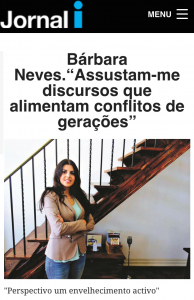 I was interviewed last week for the Portuguese newspaper i. It was a piece by a brilliant journalist, Ana Tomás, so it turned out to be a fun and insightful conversation. It is always interesting to reflect on what was asked and in what context — see my previous post on my Canadian TV interview. Here are some brief (quick and dirty) reflections.
I was interviewed last week for the Portuguese newspaper i. It was a piece by a brilliant journalist, Ana Tomás, so it turned out to be a fun and insightful conversation. It is always interesting to reflect on what was asked and in what context — see my previous post on my Canadian TV interview. Here are some brief (quick and dirty) reflections.
The interview was mostly about how my generation (generation Y, if you are into those labels) will adapt to new technologies as we age. The assumption is that it will be easier for us, since we are used to new technologies. This reminded me of two questions people ask me constantly:
1) Why are you “into old people”? I have heard this question more often than I could expect, which also taps into a certain widespread ageism…
2) Don’t you think this problem (of an age-based digital divide) will be solved within one generation?
First of all, I am interested in aging in a life course perspective; I have also studied use and non-use amongst young adults. Second, not quite. I am not a futurologist, but I think we deceive ourselves into believing that our generation will not have these problems, because we grew up with touchscreen devices and the Web. My research suggests two ideas that might help deconstruct the aforementioned assumption:
1. The technology of today is not the technology of tomorrow, specially in the fast-paced realm of ICTs.
2. As we age, our needs, bodies, and abilities also change.
The fast development of ICTs implies changing demands on digital literacy and critical skills, which are linked to socioeconomic dimensions. Technology is also socially shaped: i.e., there are social and ideological choices embedded in the design and implementation of any technology. Most technologies are not generally designed for older adults, since young people are the usual target demographic, and the most avid consumers of new technology.
To give an example of this process, at TAGlab we developed an accessible communication app for frail and other older adults called InTouch. However, even though we tried to create an accessible app with large fonts, large icons, and an intuitive interface, we had problems with the hardware as soon as we deployed InTouch. The tablets were too heavy for some of our participants (a few only had the use of one hand, being stroke survivors) and most could not find the side on/off button, due to dexterity and motor issues. We had to paint it with nail polish to help them find the buttons.
In brief, I actually think we will face similar problems. It is crucial, therefore, to continue to look at how technology can be developed for and with older adults – their agency has to be taken seriously in the design and implementation of technology.
